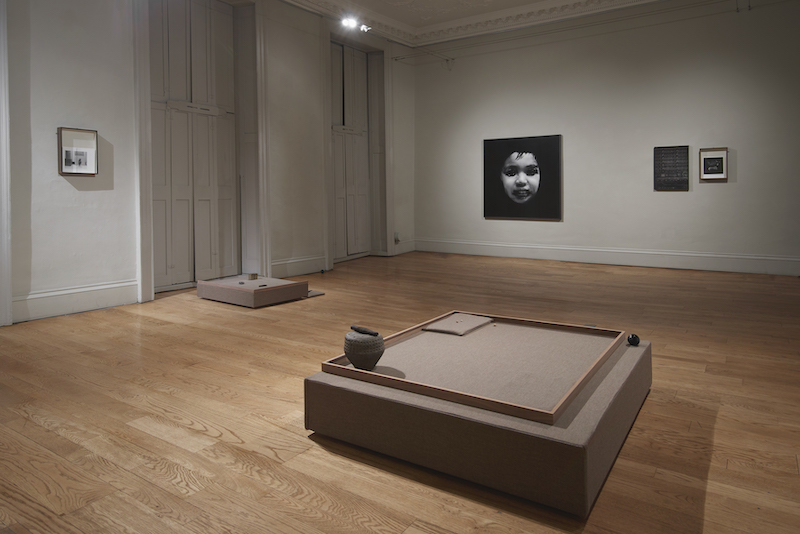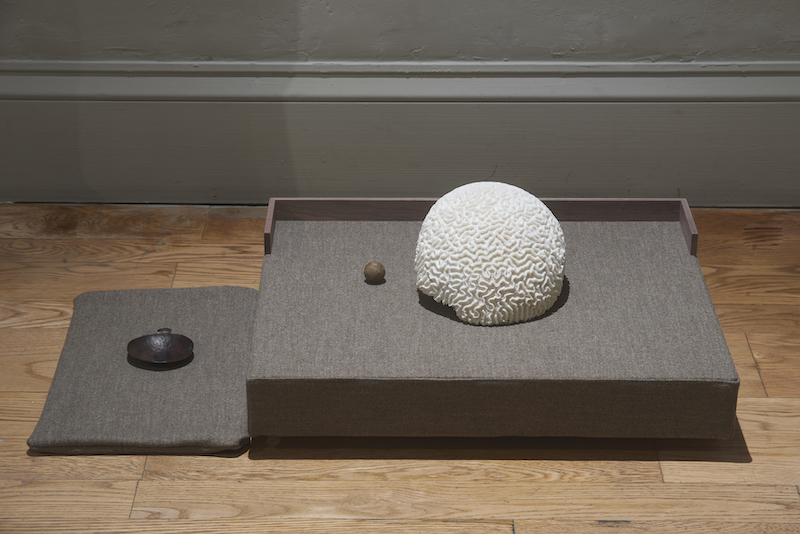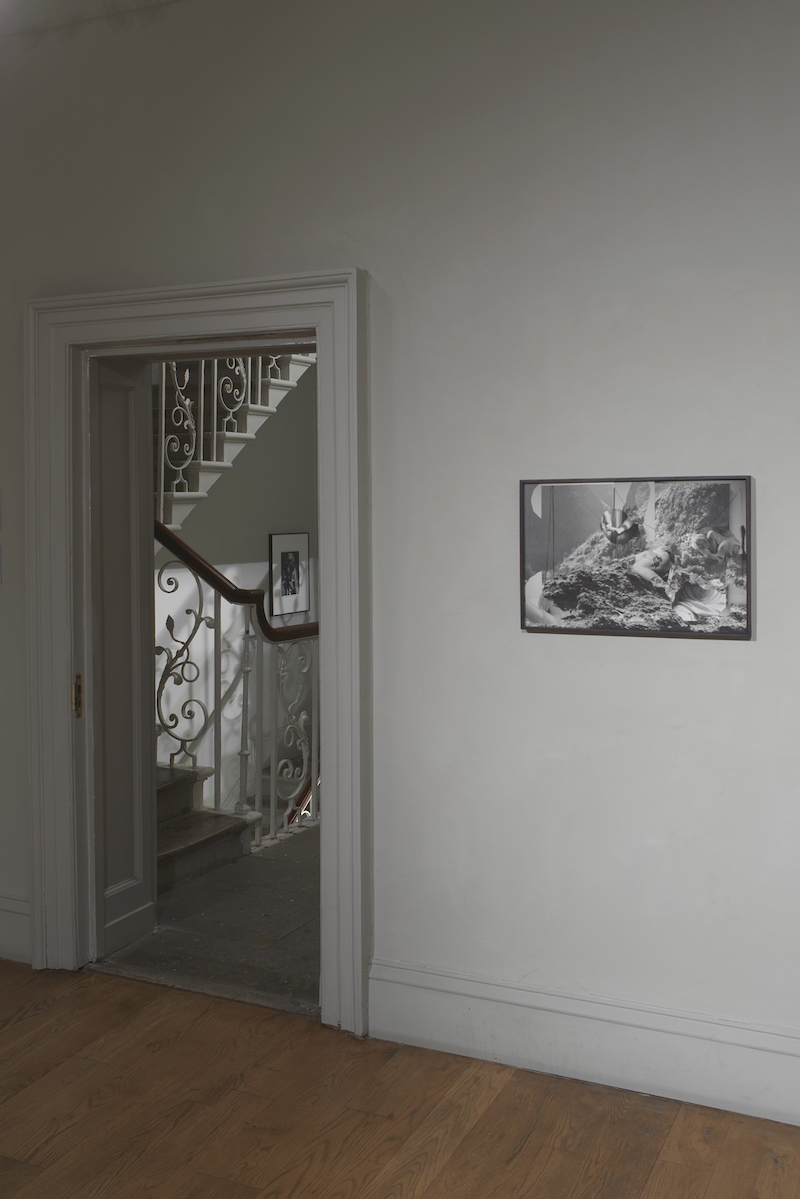
Ailbhe Ní Bhriain “Inscriptions of an Immense Theatre “, Film Still, 2018 © the artist
Ailbhe Ní Bhriain is presenting “Inscriptions IV”, her fourth solo exhibition at Domobaal Gallery in London, including her photographic, tapestry and sculptural works. In our interview she spoke about her collaboration with an algorithm and her recent video works selected for the Artists’ Film Festival.
Mine Kaplangi: When I first visit your studio in Cork last year, I immediately realized that all these different media were connected with an invisible bond through your working process. It was an eerie experience to walk around between the sound, the image, the installation and the large photographs that were leaned against the walls. How you would describe the connectivity of your practice?
Ailbhe Ni Bhriain: Increasingly I think of my work as a kind of suspended storytelling – so I like your description of an ‘invisible bond’. My process is one of bringing multiple elements together, often from quite different sources, and seeing what happens – shuffling things around until an alternative kind of logic starts to gather force. I tend to start off with locations that connect to representation on a wide, collective level – museums for example, or archetypal landscapes. I’m interested in locations that carry this kind of weight of prescribed cultural narrative. My work is an attempt to reconfigure these familiar sites or images, with the hope that they become less immediately legible, or come to suggest multiple, simultaneous narratives. With film I do this using CGI and compositing techniques and with photography I work with collage. In both cases I am trying to create dreamlike hybrids out of overly inscribed material. I guess I am trying to access a slipperiness in representation and in how we construct meaning – and within this, trying to subtly point to the ways in which, culturally, meaning has been constructed for us.




Ailbhe Ní Bhriain "Inscriptions IV" at Domobaal in London, Photo: Andy Keate, © the artist
MK: Currently you have a solo exhibition "Inscriptions IV" at Domobaal in London. Could you tell me about the concept of the exhibition?
ANB: “Inscriptions IV” is an unusual show for me, in that it’s an exhibition without film. Instead, motifs that run through my films play themselves out as an installation – of photography, collage, tapestry and objects. The title of the show refers to a text from 1865 called “Inscriptions of the Immense Theatre.” This text has formed a seam through my last four bodies of work. It’s thought to be the earliest published text on museums – essentially it’s like an instruction manual for creating a private collection. But in setting out how to collect and classify the objects of the world, it is also in effect outlining the construction of the western imperial narrative. An exploration of this link between systems of representation and cultural control underpins a lot of my recent work.
MK: How does this play out in the works of the show?
ANB: One of the central works in “Inscription IV” is a large–scale Jacquard tapestry that combines early colonial portrait photography with imagery of excavated quarry walls. The two images are brought together through an abrupt kind of collage, which is later digitally translated to a jacquard loom. Working with orientalist photography, I was trying to interrupt a familiar form of representation – basically a Western fantasy constructing itself as an authentic cultural document. Collage is the means of interruption, a way of alluding to the encoded loss behind this representation. Another work in the show that plays with this idea of portraiture and construct is “Untitled (Adversary)”, though in this case the image is made up of overlaid AI generated portraits. Here I was trying to echo the process of machine learning – the way in which AI works from our composite collective image to evolve a new identity. In combining multiple ‘false’ portraits within a single image, I was in a sense trying to replicate this logic, looking for a similar kind of distillation within these perfect fakes. The image that emerged is quite unnerving.
There are a lot of different kind of registers in this show – shifts in scale, materials, types of imagery and presentation. There are large abstract works, small still lives, found and crafted objects, portrait imagery, prints on aluminum and cotton, with references that span from early computing technology to historic specimen collections, landscape to Assyrian artifacts. I’m deliberately playing with different forms of representation and categorization. But the show isn’t concerned with straightforward critique – I want it to evoke curiosity, to draw the viewer into an intuitive, permeable kind of logic. I’ve always been interested in the way that things affect each other through pure proximity. Whether its objects placed next to each other in a museum case or the cut between one image and another in a film edit - we automatically work to conjoin things in a narrative way. This show plays with these narrative tensions, but deliberately avoids resolutions. Instead I’m looking for unexpected connections between things, connections that somehow make visible the contradictions - and the absences - embedded in representation itself.




Ailbhe Ní Bhriain "Inscriptions IV" at Domobaal in London, Photo: Andy Keate, © the artist
MK: In the main gallery room there is a pigment print on hand-coated cotton titled “Untitled (The Sublime and The Good)”. Can you tell me about its story and relation to the exhibition?
ANB: This work came about from a commission to respond to the philosophy of Iris Murdoch. It was my first introduction to Murdoch’s philosophical work, so it was a real gift – I was thrilled by the immediacy of this writing. The piece I made was a response to Murdoch’s essay “The Sublime and the Good”, where she tackles definitions of art, morality and the sublime via Tolstoy, Kant and Hegel. She manages to present and collapse ideals with a brilliant swiftness in this essay. Rather than trying to represent her remarkable writing in any direct way, I set about staging an image from these collapsed ideals – playing with fragments of romantic landscape, artfully aimless lines and classical depictions of love and morality. It’s a collection of impressions loosely gathered from the essay, including Murdoch’s own arrived-at ideal (love) and its adversary (fantasy). The collage includes a detail from a famous Gian Lorenzo Bernini sculpture, representing the abduction of Proserpina to the underworld – a reference to Murdoch’s description of fantasy. Within the exhibition this links to surrounding works in alluding to the dark fantasy shaping our construction of the ideal – whether those constructs and ideals are imperial or digital in origin.
 Ailbhe Ní Bhriain "Inscriptions IV" at Domobaal in London, Photo: Andy Keate, © the artist
Ailbhe Ní Bhriain "Inscriptions IV" at Domobaal in London, Photo: Andy Keate, © the artist
 Ailbhe Ní Bhriain "Inscriptions IV" at Domobaal in London, Photo: Andy Keate, © the artist
Ailbhe Ní Bhriain "Inscriptions IV" at Domobaal in London, Photo: Andy Keate, © the artist
MK: Parallel to this exhibition, the Whitechapel Gallery hosted a screening of your film “Inscriptions of an Immense Theatre “ from 2018. What is the film about?
ANB: It’s great to have worked with the Whitechapel on this. The film “Inscriptions of an Immense Theatre” was a long time in the making and Gareth Evans, who curated this event, has been committed to it from the very beginning. The film is set in three locations – a gallery housing the earliest collection of the British Museum, a temporary accommodation center for asylum seekers, and an active stone quarry. I worked with live and computer generated elements to weave these sites together, and with them the interconnected issues of imperial legacy, human displacement and the anthropocene. These are weighty subjects, but the film tries to draw us into a kind of suspension – a space of simultaneous truths and reflection rather than polemic. All of the sites have been transformed into surreal states, semi submerged in water and inhabited by a lone monkey and various birds of prey. They are often encountered from unsettling or inverted camera positions – overall the film is quite deliberately disorientating, placing us in a kind of a future-aftermath. Susan Stenger composed the soundtrack for the film – she drew on morse code and traditional Irish keening to create these melodic laments that are pretty mesmerizing. A voiceover, performed by Eileen Walsh, references the original museological text I spoke about earlier – “Inscriptions of the Immense Theatre” by Samuel Quiccheberg. This text is encountered through collaged fragments, with its meaning and application rendered deliberately nebulous. Set against the different locations of the accommodation center and the excavated natural landscape, the text comes to suggest wider implications of imperial aspiration. The work at Domobaal gallery and the work screening at Whitechapel definitely interconnect in terms of the approach to subject and narrative – but one plays itself out as a film sequence and the other operates spatially and materially within the gallery.
MK: Your work “Inscriptions (One Here Now)” is part of the project Artists’ Film International, originally initiated by the Whitechapel gallery and now an international and collaborative network of institutions doing a touring screening program. Can you tell me more about the project and about how your work relates to this year’s program?
ANB: AFI is an incredible program to be part of – a collaborative project established by the Whitechapel in 2008 that now links to 21 partner organizations across the world. “Inscriptions (One Here Now)”, which is a separate though related work to “Inscriptions of an Immense Theatre”, will show at each of these venues throughout 2020. Among them are the Hammer Museum in LA, the Museum of Modern Art in Warsaw, the Istanbul Modern and the Whitworth in Manchester. “Inscriptions (One Here Now)” was originally commissioned by Miranda Driscoll for Sirius Arts Centre in Cork, as a response to a site-specific wall painting by the artist Brian O’Doherty. The work was then proposed by Dawn Williams at Crawford Art Gallery for Artists’ Film International, which is working with the curatorial theme of “Language” this year. Embedded within the film are references to the ancient Irish language of Ogham, a script which took the form of linear strokes cut into vertical standing stones. The camera in “Inscriptions (One Here Now)” travels into the negative space of a quarry interior, attempting to ‘read’ the quarry walls. It traces the deep time of geological sequences, the scars left by machinery on the rock surfaces, and the sprayed industrial notations that codify the commodification and disappearance of landscape. These different forms of inscription act as a metaphor for the anthropocene in this film – a meditation on our current geological era, and the reality of environment and climate shaped by human behavior.
 Ailbhe Ní Bhriain “Inscriptions of an Immense Theatre “, Film Still, 2018 © the artist
Ailbhe Ní Bhriain “Inscriptions of an Immense Theatre “, Film Still, 2018 © the artist
 Ailbhe Ní Bhriain “Inscriptions of an Immense Theatre “, Film Still, 2018 © the artist
Ailbhe Ní Bhriain “Inscriptions of an Immense Theatre “, Film Still, 2018 © the artist
MK: What are you working on at the moment?
ANB: Right now I’m immersed in production for a new film ‘An Experiment with Time’. This looks at sites of medical, technological and religious history through the lens of a future destabilized by climate crisis. This has been funded by the Arts Council of Ireland, which has been so important to the development of my work over the years. It’s an odd film; drawing in elements of AI, precognitive dreams, a lone chameleon…but it’s got its own logic.
Current Exhibitions
Inscriptions IV
Solo exhibition at Domobaal, London, 14.02.20 –
Inscriptions of an Immense Theatre
Solo screening event at Whitechapel Gallery
Curated by Gareth Evans, 05.03.20
Artists Film International
Ailbhe Ni Bhriain, Raks Media Collective, Lerato Shadi & Yo Guo at Crawford Art Gallery, Cork
23.03.20 – 26.04.20
Ailbhe Ni Bhriain, Dominika Olszowy and Lisa Tan
Whitechapel Gallery, London, 24.03.20 – 26.05.20
